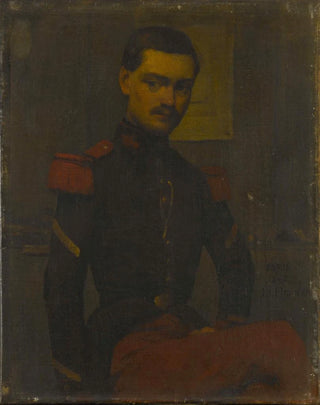Art print | Portrait of Sergeant Fourrier - Jean-Jacques Henner


View from behind

Frame (optional)
The "Portrait of Sergeant Fourrier" by Jean-Jacques Henner is a work that transcends the simple frame of a portrait to immerse the viewer in a universe of profound intimacy and palpable emotion. Created in the 19th century, this painting embodies not only the technical skill of its creator but also an era when art was closely intertwined with daily life and military values. In this piece, Henner manages to capture the very essence of his model, a sergeant fourrier whose gaze seems to tell stories of bravery and dedication. The viewer faces a man whose dignity and humanity emanate through every brushstroke, creating a strong emotional connection that crosses time.
Style and uniqueness of the work
Henner stands out for his bold use of light and shadow, a technique that gives his portraits an almost mystical atmosphere. In the "Portrait of Sergeant Fourrier," delicate nuances of flesh contrast with deep shadows surrounding the character, thus accentuating his expression and stature. The artist skillfully plays with textures, making the canvas almost tactile, as if one could feel the robustness of the military uniform. The background, blurred and indistinct, highlights the subject, creating a depth that draws the eye and invites contemplation. Every detail, from the creasing of the uniform to the intensity of the gaze, testifies to Henner's mastery, who manages to convey a vibrant humanity through a simple representation.
The artist and his influence
Jean-Jacques Henner, born in 1829 in Strasbourg, is an emblematic figure of the French artistic movement of the 19th century. His journey, marked by training at the École des beaux-arts in Paris, led him to develop a unique style, blending influences of Romanticism and Realism. Henner was also inspired by Renaissance masters, incorporating elements of sensuality and mystery into his works. Beyond his technique, Henner knew how to capture the spirit of his time, addressing themes such as war, solitude, and human dignity. His

Matte finish

View from behind

Frame (optional)
The "Portrait of Sergeant Fourrier" by Jean-Jacques Henner is a work that transcends the simple frame of a portrait to immerse the viewer in a universe of profound intimacy and palpable emotion. Created in the 19th century, this painting embodies not only the technical skill of its creator but also an era when art was closely intertwined with daily life and military values. In this piece, Henner manages to capture the very essence of his model, a sergeant fourrier whose gaze seems to tell stories of bravery and dedication. The viewer faces a man whose dignity and humanity emanate through every brushstroke, creating a strong emotional connection that crosses time.
Style and uniqueness of the work
Henner stands out for his bold use of light and shadow, a technique that gives his portraits an almost mystical atmosphere. In the "Portrait of Sergeant Fourrier," delicate nuances of flesh contrast with deep shadows surrounding the character, thus accentuating his expression and stature. The artist skillfully plays with textures, making the canvas almost tactile, as if one could feel the robustness of the military uniform. The background, blurred and indistinct, highlights the subject, creating a depth that draws the eye and invites contemplation. Every detail, from the creasing of the uniform to the intensity of the gaze, testifies to Henner's mastery, who manages to convey a vibrant humanity through a simple representation.
The artist and his influence
Jean-Jacques Henner, born in 1829 in Strasbourg, is an emblematic figure of the French artistic movement of the 19th century. His journey, marked by training at the École des beaux-arts in Paris, led him to develop a unique style, blending influences of Romanticism and Realism. Henner was also inspired by Renaissance masters, incorporating elements of sensuality and mystery into his works. Beyond his technique, Henner knew how to capture the spirit of his time, addressing themes such as war, solitude, and human dignity. His






